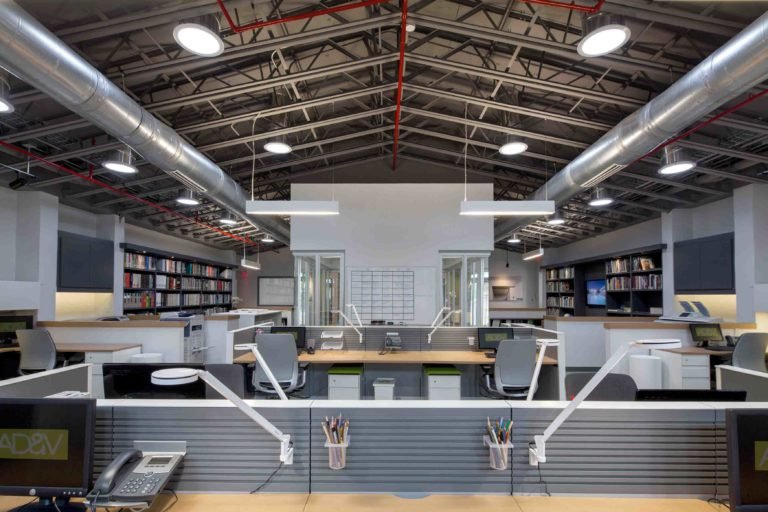Technology & Interior Design: A Match Made in Heaven
Written By Cristina VillalónABOUT THE AUTHOR | Cristina Villalón is the Co-Founder and Lead Designer at Álvarez-Díaz & Villalón. She directs both the Interior Design and Visual Merchandising divisions while overseeing all decisions made on a day-to-day basis at the firm.
Technology has not only shaped the interior design industry, it continues to evolve and integrate seamlessly with it.
Combining technology and interior design has given interior designers the ability to work faster, smarter, and more sustainably.Learn why technology and interior design are perfect for each other:
SMART SPACES
The era of the Smart Home is going to get even smarter. People are using smart devices in their home so they can control the temperature, lighting, electrical fields, and appliances, either through the touch of a button or voice activation. The Smart Home takeover began with Amazon and Google. With Google Home devices, for example, you can control your home’s compatible plugs, alarms, locks, displays, light bulbs, thermostats, sound systems, and more without lifting a finger.Similarly, smart mirrors are also being integrated into homes. Smart mirrors feature touchscreen buttons that allow you to check weather reports, news headlines, sports scores, and more. Electric Mirror is one company known for producing stylish and elegant smart mirrors for different rooms around the house. Interior designers are using these types of smart devices and furnishings to improve home experiences for the end user.
DYNAMIC & MODULAR ENVIRONMENTS
As new technologies emerge, interior designers are integrating smart materials to create dynamic and modular environments. Dynamic environments feature walls that adjust to the perfect room temperature, furniture that acts as a power source, color changing wallpapers, and other innovative applications.Modular environments give interior designers the opportunity to incorporate versatility, flexibility and connectivity through scaled down furniture made for specific technologies, wall panels that can be added or relocated, and rooms that can be moved or enlarged to create custom spaces.
GREEN DESIGN
Energy conservation and “green” design has become the status quo in interior design. People are expecting sustainable solutions and are also evaluating their environmental impact.More eco-friendly practices that support sustainability and connect people to local culture and history, are being integrated into interior design. Natural light, solar panels, recycled wood, organic materials, hourglass timers in showers, locally handcrafted items and repurposed furniture are trending. More and more, designers are using daylighting techniques, natural ventilation, indoor gardens, and organic building materials, with every element helping to support a sustainable lifestyle.
3D PRINTED LIVING
When it comes to manufacturing products, 3D printing has already been able to create furnishings and houses using eco-friendly materials. Companies have already begun crafting and selling beautiful 3D printed lamps, chairs, tables, and other furniture. The ability to mass produce different types of 3D printed furnishings and other décor materials will take interior designers by storm. To be able to have a wide variety of sustainable and affordable 3D printed furnishings at our disposal will change the interior design industry forever.
TINY HOUSES
The Tiny House concept is revolutionizing home design. Tiny Houses are small 400 square foot homes that are being built all over the world in order to create minimal and efficient living spaces. People are building them to simplify their lives, eliminate wastefulness, decrease their cost of living as well as their carbon footprint. This concept is about minimizing space, to value what’s truly important instead of focusing on material possessions. Tiny Houses have become so popular that there’s even a reality television series about it.With Tiny Houses, interior designers are faced with creating a compact, appealing, and all-purpose living space. Since the space in the home is scarce, everything inside of it should serve a specific function or have more than one use. For example, a kitchen table that morphs into TV stand or stairs that have storage space. As Tiny Houses keep emerging, interior designers need to keep up with the rising smart technologies that highlight reduced living spaces.
NEW REALITIES
Augmented reality (AR) and Virtual reality (VR) technologies have changed the way interior designers work with their clients. These technologies combine the virtual world with the real world by overlaying virtual features on top of actual ones. Designers are using AR smartphone applications to test out designs with their clients. For example, home furnishing company Chairish, has an app with an AR feature that lets users instantly visualize how Chairish’s furniture and décor products will look like in their home without even purchasing them.Virtual reality also offers interior designers an exciting, dynamic way to work and present ideas to their clients. Interior designers are using virtual reality to showcase their creations to clients by creating a walkthrough project experience that engages them in the design process. With VR, clients are able to test different types of wallpaper designs, furniture pieces or flooring types at the click of a button. Thanks to these technologies, people now have the ability to collaborate with interior designers in order to see and help create their home space.
WHAT THE FUTURE HOLDS
The future looks exciting for technology and interior design. As technology continues to advance at a quick pace, expect to see new and innovative technologies, more smart spaces and dynamic environments, sustainable living solutions, compact spaces, virtual reality tools, and 3D printed homes and furnishings. As the notorious Disney amusement park ride states “There’s a great, big beautiful, tomorrow.” Wait for it!To learn how technology is transforming the hospitality industry and how to use it to boost the guest experience to a new level, download this helpful guide.



